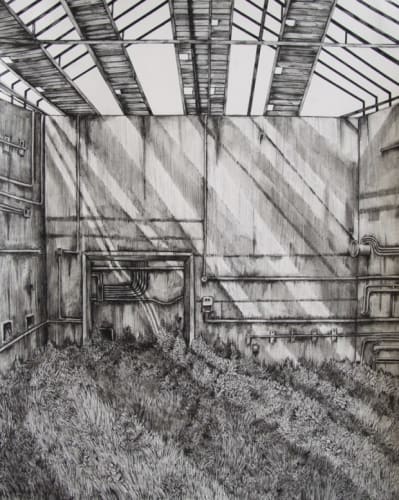Browse & Darby are delighted to announce the first solo show of work by British contemporary artist Olivia Kemp (b. 1990). The exhibition will occupy the first-floor gallery and showcase a number of the artist’s pen and ink drawings, alongside several smaller works completed during residencies at Dumfries House, Scotland; Borgo Pignano, Italy, and Hølen, Norway.
Olivia Kemp: Where the Land Lies
Past exhibition
Upon a first encounter with Kemp’s work one is struck by the sheer skill of her draughtsmanship. Seen from afar her richly drawn surfaces appear like a dense fabric of impenetrable line, monochromatic, yet magnetic, their labyrinthine complexity giving way to passages of exquisitely drawn detail under closer inspection.
Kemp’s subject matter ranges from the beguiling to the bizarre; derelict cabins, eerie wasteland, abandoned cars, hedgerows, scrap heaps, fantastical floating islands and strange creatures. Her fascination with the peculiar and macabre is contagious as she delights in the incongruous and manmade in the natural environment. Indeed, there is a particular romance in the gradual appropriation of the foliage and moss on a neglected barn or VW campervan. A voracious reader, Kemp incorporates these ideas about nature, the wilderness and our relationship with it, lifted from passages in literature and poetry. She describes becoming ‘hooked on certain objects – tree stumps, tents, lighthouses, treehouses’ which hold significance in time, place or memory.
The drawings in this exhibition are largely based on observational studies made in Norway, Italy and Scotland. Real life scenery is interwoven with imaginary elements, creating an altogether surreal effect which is further heightened by the subtle discrepancies in perspective. Large compositions such as Archipelago, a surreal collection of imagined Nordic islands floating in space, evolve in an organic manner akin to the ivy creeping over the abandoned campervan in the drawing entitled Hedgerow. While her smaller, observational drawings ‘form a kind of language that…adds substance to larger works’.
Pen and ink – favoured for their indelible nature – are handled with an assuredness that belies the artist’s age. Thrilled by the challenge of being ‘always on the edge of making an irrevocable mistake’, Kemp relishes the all-consuming aspect of working with such unforgiving media. She describes the trance-like state entered when producing such immaculate work and on such a daunting scale. Each mark is meticulously considered, and yet she herself admits that the final results are often as surprising to her as they are to the viewer.
Kemp’s work rewards the curious and perceptive. Each drawing offers a collage of intriguing imagery, interwoven with witty detail and symbolism. Her brocade-like surfaces and composite iconographies are reminiscent of early Renaissance woodcuts by Albrecht Durer, while her ability to conjure a mood laced with abstruse, sometimes disquieting murmurings harks back to the etchings of the French, nineteenth-century printmaker Gustave Doré. In her own words:
‘I draw in order to make sense of the landscape, but also to construct and re-model it. I build worlds and imaginary places…this encompasses everything, from the visions of a grand landscape right down to the details of the land, the plants and creatures that may inhabit it.’

